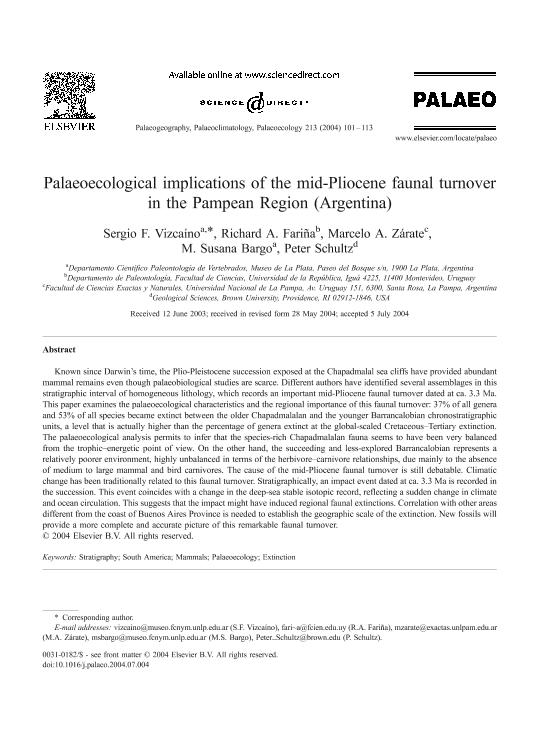Mostrar el registro sencillo del ítem
dc.contributor.author
Vizcaíno, Sergio Fabián

dc.contributor.author
Fariña, Richard A.
dc.contributor.author
Zárate, Marcelo Arístides

dc.contributor.author
Bargo, María Susana

dc.contributor.author
Schultz, Peter
dc.date.available
2019-08-16T18:54:00Z
dc.date.issued
2004-10
dc.identifier.citation
Vizcaíno, Sergio Fabián; Fariña, Richard A.; Zárate, Marcelo Arístides; Bargo, María Susana; Schultz, Peter; Palaeoecological implications of the mid-Pliocene faunal turnover in the Pampean Region (Argentina); Elsevier Science; Palaeogeography, Palaeoclimatology, Palaeoecology; 213; 1-2; 10-2004; 101-113
dc.identifier.issn
0031-0182
dc.identifier.uri
http://hdl.handle.net/11336/81756
dc.description.abstract
Known since Darwin's time, the Plio-Pleistocene succession exposed at the Chapadmalal sea cliffs have provided abundant mammal remains even though palaeobiological studies are scarce. Different authors have identified several assemblages in this stratigraphic interval of homogeneous lithology, which records an important mid-Pliocene faunal turnover dated at ca. 3.3 Ma. This paper examines the palaeoecological characteristics and the regional importance of this faunal turnover: 37% of all genera and 53% of all species became extinct between the older Chapadmalalan and the younger Barrancalobian chronostratigraphic units, a level that is actually higher than the percentage of genera extinct at the global-scaled Cretaceous - Tertiary extinction. The palaeoecological analysis permits to infer that the species-rich Chapadmalalan fauna seems to have been very balanced from the trophic - energetic point of view. On the other hand, the succeeding and less-explored Barrancalobian represents a relatively poorer environment, highly unbalanced in terms of the herbivore - carnivore relationships, due mainly to the absence of medium to large mammal and bird carnivores. The cause of the mid-Pliocene faunal turnover is still debatable. Climatic change has been traditionally related to this faunal turnover. Stratigraphically, an impact event dated at ca. 3.3 Ma is recorded in the succession. This event coincides with a change in the deep-sea stable isotopic record, reflecting a sudden change in climate and ocean circulation. This suggests that the impact might have induced regional faunal extinctions. Correlation with other areas different from the coast of Buenos Aires Province is needed to establish the geographic scale of the extinction. New fossils will provide a more complete and accurate picture of this remarkable faunal turnover.
dc.format
application/pdf
dc.language.iso
eng
dc.publisher
Elsevier Science

dc.rights
info:eu-repo/semantics/openAccess
dc.rights.uri
https://creativecommons.org/licenses/by-nc-sa/2.5/ar/
dc.subject
Extinction
dc.subject
Mammals
dc.subject
Palaeoecology
dc.subject
South America
dc.subject
Stratigraphy
dc.subject.classification
Paleontología

dc.subject.classification
Ciencias de la Tierra y relacionadas con el Medio Ambiente

dc.subject.classification
CIENCIAS NATURALES Y EXACTAS

dc.title
Palaeoecological implications of the mid-Pliocene faunal turnover in the Pampean Region (Argentina)
dc.type
info:eu-repo/semantics/article
dc.type
info:ar-repo/semantics/artículo
dc.type
info:eu-repo/semantics/publishedVersion
dc.date.updated
2019-08-15T16:21:54Z
dc.journal.volume
213
dc.journal.number
1-2
dc.journal.pagination
101-113
dc.journal.pais
Países Bajos

dc.journal.ciudad
Amsterdam
dc.description.fil
Fil: Vizcaíno, Sergio Fabián. Consejo Nacional de Investigaciones Científicas y Técnicas; Argentina. Universidad Nacional de La Plata. Facultad de Ciencias Naturales y Museo. Departamento Científico de Paleontología de Vertebrados; Argentina
dc.description.fil
Fil: Fariña, Richard A.. Universidad de la República; Uruguay
dc.description.fil
Fil: Zárate, Marcelo Arístides. Consejo Nacional de Investigaciones Científicas y Técnicas. Instituto de Ciencias de la Tierra y Ambientales de La Pampa. Universidad Nacional de La Pampa. Facultad de Ciencias Exactas y Naturales. Instituto de Ciencias de la Tierra y Ambientales de La Pampa; Argentina
dc.description.fil
Fil: Bargo, María Susana. Consejo Nacional de Investigaciones Científicas y Técnicas; Argentina. Universidad Nacional de La Plata. Facultad de Ciencias Naturales y Museo. Departamento Científico de Paleontología de Vertebrados; Argentina
dc.description.fil
Fil: Schultz, Peter. University Brown; Estados Unidos
dc.journal.title
Palaeogeography, Palaeoclimatology, Palaeoecology

dc.relation.alternativeid
info:eu-repo/semantics/altIdentifier/doi/https://doi.org/10.1016/j.palaeo.2004.07.004
dc.relation.alternativeid
info:eu-repo/semantics/altIdentifier/url/https://www.sciencedirect.com/science/article/pii/S0031018204003657
Archivos asociados
